What'sNEW Archives, August-September 2003
September 26  bacteria from 41 km bacteria from 41 km |
Lawrence Livermore National Laboratory will measure isotope ratios in bacteria from the high atmosphere. Testing is scheduled for October on the NanoSIMS machine at LLNL's ion microprobe facility in Livermore, California, with the collaboration of physicist Ian D. Hutcheon. The bacteria were recovered by balloon-borne equipment at altitudes up to 41 km over Hyderabad, India, 21 January 2001. Their identity as bacteria has been confirmed by several methods. The ratios of Carbon, Nitrogen and Oxygen isotopes should clearly show whether any of the bacteria are extraterrestrial.
 31 Mar 2004: Isotope tests inconclusive. 31 Mar 2004: Isotope tests inconclusive.
 8 Jan 2004: Isotope analysis of stratospheric bacteria is postponed. 8 Jan 2004: Isotope analysis of stratospheric bacteria is postponed.
 Ian D. Hutcheon — homepage at Lawrence Livermore National Laboratory. Ian D. Hutcheon — homepage at Lawrence Livermore National Laboratory.
 An Atmospheric Test of Cometary Panspermia is the principal related CA webpage. An Atmospheric Test of Cometary Panspermia is the principal related CA webpage.
 Bacteria or Viruses in the High Atmosphere — a section of the CA webpage, "Can the Theory Be Tested?". Bacteria or Viruses in the High Atmosphere — a section of the CA webpage, "Can the Theory Be Tested?".
September 16 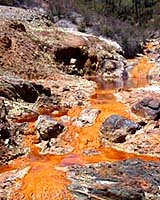 A river in Spain may model Mars' environment and help NASA learn how to look for life on the red planet. At the Sixth International Mars Society Conference in Eugene Oregon, 14-17 August, Carol Stoker of NASA, Ames, explains that bacteria might dwell underground on Mars as they do near Spain's very acidic Rio Tinto. This research is part of the Mars Analog Research and Technology Experiment (MARTE). [Thanks, Marsbugs.]
A river in Spain may model Mars' environment and help NASA learn how to look for life on the red planet. At the Sixth International Mars Society Conference in Eugene Oregon, 14-17 August, Carol Stoker of NASA, Ames, explains that bacteria might dwell underground on Mars as they do near Spain's very acidic Rio Tinto. This research is part of the Mars Analog Research and Technology Experiment (MARTE). [Thanks, Marsbugs.]
 From a River in Spain to a Crater on Mars, Interview with Andrew Knoll, Astrobiology Magazine, 2 Feb 2004. From a River in Spain to a Crater on Mars, Interview with Andrew Knoll, Astrobiology Magazine, 2 Feb 2004.
 Mars Underground: Digging Deep for Life, by Leonard David, Space.com, 5 Sep 2003. Mars Underground: Digging Deep for Life, by Leonard David, Space.com, 5 Sep 2003.
 Scientists Practice Mars Drilling Near Acidic Spanish River, SpaceDaily.com, 23 Sep 2003. Scientists Practice Mars Drilling Near Acidic Spanish River, SpaceDaily.com, 23 Sep 2003.
September 15 A freezing cold Mars could have supported life, just as cold deserts on Earth do. With impressive data, respected astrobiologist Chris McKay makes the case at a meeting of the American Astronomical Society in Monterey, California, 2-6 September. He also suggests that the Viking life-detection experiments on Mars, in 1976-77, were flawed by false assumptions.
 Early Mars Was Frozen But Habitable: Part I, by Chris McKay, Astrobiology Magazine, 15 Sep 2003. Early Mars Was Frozen But Habitable: Part I, by Chris McKay, Astrobiology Magazine, 15 Sep 2003.
 Early Mars ...Part II, by Chris McKay, Astrobiology Magazine, 22 Sep 2003. Early Mars ...Part II, by Chris McKay, Astrobiology Magazine, 22 Sep 2003.
 Life on Mars! is a related CA webpage with lots about the Viking experiments. Life on Mars! is a related CA webpage with lots about the Viking experiments.
September 15  Galileo will crash into Jupiter on Sunday, 21 September. NASA is destroying the spacecraft this way to assure that it doesn't contaminate Europa with earthly microbes. Striking Jupiter's dense atmosphere at over 100,000 mph, the probe should be pulverized and its contents sterilized by intense heat. Launched in 1989, Galileo has returned images and information from Jupiter and its moons since December 1995.
Galileo will crash into Jupiter on Sunday, 21 September. NASA is destroying the spacecraft this way to assure that it doesn't contaminate Europa with earthly microbes. Striking Jupiter's dense atmosphere at over 100,000 mph, the probe should be pulverized and its contents sterilized by intense heat. Launched in 1989, Galileo has returned images and information from Jupiter and its moons since December 1995.
 NASA to Crash Galileo Probe Into Jupiter, by Andrew Bridges, LATimes.com, 14 Sep 2003. NASA to Crash Galileo Probe Into Jupiter, by Andrew Bridges, LATimes.com, 14 Sep 2003.
 Galileo End of Mission Status, NASA, JPL News Release, 21 Sep 2003. Galileo End of Mission Status, NASA, JPL News Release, 21 Sep 2003.
 Michael Carroll, "The long goodbye," p 36-41 v 31 n 10, Astronomy, October 2003. Michael Carroll, "The long goodbye," p 36-41 v 31 n 10, Astronomy, October 2003.
 Bacteria... is a related CA webpage about the hardiness of bacteria. Bacteria... is a related CA webpage about the hardiness of bacteria.
 Life on Europa or Other Moons? is a related CA linkspage. Life on Europa or Other Moons? is a related CA linkspage.
September 14
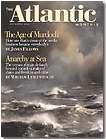 The theological implications of life elsewhere are considered by astrobiologist Paul Davies in The Atlantic Monthly. The topic has interested him at least since he wrote Are We Alone? (Basic Books, 1995.) The topic interest us too, but in this writing Davies has blinders on when he discusses the possible implications if life is found on Mars. "If traces of past life were discovered on Mars but found to be identical to some form of terrestrial life, transportation by ejected rocks would be the most plausible explanation, and we would still lack evidence that life had started from scratch in two separate locations." Yes we would. In fact, we would lack evidence that life had started from scratch in either location. It may have come to both planets from a cosmic source. [Thanks, Jim McGee.]
The theological implications of life elsewhere are considered by astrobiologist Paul Davies in The Atlantic Monthly. The topic has interested him at least since he wrote Are We Alone? (Basic Books, 1995.) The topic interest us too, but in this writing Davies has blinders on when he discusses the possible implications if life is found on Mars. "If traces of past life were discovered on Mars but found to be identical to some form of terrestrial life, transportation by ejected rocks would be the most plausible explanation, and we would still lack evidence that life had started from scratch in two separate locations." Yes we would. In fact, we would lack evidence that life had started from scratch in either location. It may have come to both planets from a cosmic source. [Thanks, Jim McGee.]
 Paul Davies, "E.T. and God: Could earthly religions survive the discovery of life elsewhere in the universe?," v 292 n 2, The Atlantic Monthly, September 2003. Paul Davies, "E.T. and God: Could earthly religions survive the discovery of life elsewhere in the universe?," v 292 n 2, The Atlantic Monthly, September 2003.
 Evolution vs Creationism is a related CA webpage. Evolution vs Creationism is a related CA webpage.
 What Difference Does It Make? is a related CA webpage. What Difference Does It Make? is a related CA webpage.
September 8  Oceans and pleasant temperatures may have persisted on Venus for two billion years. So says David Grinspoon of the Southwest Research Institute in Texas, who included the effect of clouds on the Venusian atmosphere in his calculations. This work was presented at the American Astronomical Society's Division for Planetary Sciences meeting in Monterey, California, 6 September. [Thanks, Marsbugs.]
Oceans and pleasant temperatures may have persisted on Venus for two billion years. So says David Grinspoon of the Southwest Research Institute in Texas, who included the effect of clouds on the Venusian atmosphere in his calculations. This work was presented at the American Astronomical Society's Division for Planetary Sciences meeting in Monterey, California, 6 September. [Thanks, Marsbugs.]
 "Venus possibly habitable for billions of years" [text], NewScientist.com, 3 Sep 2003. "Venus possibly habitable for billions of years" [text], NewScientist.com, 3 Sep 2003.
 [44.03] Did Venus Experience One Great Transition or Two?, Bulletin of the American Astronomical Society, 35 #4, by D.H. Grinspoon and M.A. Bullock, 6 Sep 2003. [44.03] Did Venus Experience One Great Transition or Two?, Bulletin of the American Astronomical Society, 35 #4, by D.H. Grinspoon and M.A. Bullock, 6 Sep 2003.
 2003 Division for Planetary Sciences Meeting, 2-6 Sep 2003. 2003 Division for Planetary Sciences Meeting, 2-6 Sep 2003.
 Life on Europa or Other Moons? is a CA webpage of links about life elsewhere (except Mars). Life on Europa or Other Moons? is a CA webpage of links about life elsewhere (except Mars).
August 29
...We must conclude that there are no detailed Darwinian accounts of the evolution of any biochemical or cellular system, only a variety of wishful speculations. There is room for discovery here....
 Franklin M. Harold, The Way of the Cell: Molecules, Organisms and the Order of Life, Oxford University Press, 2001. p 205. Franklin M. Harold, The Way of the Cell: Molecules, Organisms and the Order of Life, Oxford University Press, 2001. p 205.
 Neo-Darwinism... is a related CA webpage. Neo-Darwinism... is a related CA webpage.
August 26  Earth's water came from comets? Many scientists think the oceans must have arrived that way, after Earth cooled from its original boiling hot condition. Surprisingly however, planets completely covered by a deep ocean should be common, according to a team at The University of Washington who used computer models to study how planets coalesce.
Earth's water came from comets? Many scientists think the oceans must have arrived that way, after Earth cooled from its original boiling hot condition. Surprisingly however, planets completely covered by a deep ocean should be common, according to a team at The University of Washington who used computer models to study how planets coalesce.
 Earth-like planets probably water-logged, by Philip Ball, Nature Science Update, 21 Aug 2003. Earth-like planets probably water-logged, by Philip Ball, Nature Science Update, 21 Aug 2003.
 Life on Europa... is a CA webpage with links about a water-world in our solar system. Life on Europa... is a CA webpage with links about a water-world in our solar system.
August 25  For travel between planets... panspermia seems entirely possible, says an article about meteorites in Natural History. Not just life's "precursor" material, but life itself, may have come from a nearby planet, the article admits. A paradigm shift toward acceptance of panspermia seems to be under way.
For travel between planets... panspermia seems entirely possible, says an article about meteorites in Natural History. Not just life's "precursor" material, but life itself, may have come from a nearby planet, the article admits. A paradigm shift toward acceptance of panspermia seems to be under way.
 Donald Goldsmith, "Bolts from Beyond" [text], p 28-34 v 112 n 7, Natural History, September 2003. Donald Goldsmith, "Bolts from Beyond" [text], p 28-34 v 112 n 7, Natural History, September 2003.
 Introduction... is a related CA webpage. Introduction... is a related CA webpage.
August 25 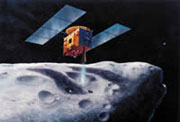 Could alien pathogens wreak havoc on our world? Three missions that will bring extraterrestrial material back to Earth are already under way. One, Japan's MUSES-C spacecraft (pictured), was launched in May 2003, bound for for asteroid 1998 SF36. There it will attempt to gather a small amount of material and return to Earth by June 2007. NASA's Stardust mission is on the way to comet Wild 2 to collect cometary dust particles for return in January 2006. And NASA's Genesis mission is now collecting solar wind samples for return in September 2004. Other future sample return missions are at various stages of development at NASA, ESA and Japan's ISAS. Material returned from space may well contain viable microorganisms, we now agree. Therefore, we must handle the samples with caution.
Could alien pathogens wreak havoc on our world? Three missions that will bring extraterrestrial material back to Earth are already under way. One, Japan's MUSES-C spacecraft (pictured), was launched in May 2003, bound for for asteroid 1998 SF36. There it will attempt to gather a small amount of material and return to Earth by June 2007. NASA's Stardust mission is on the way to comet Wild 2 to collect cometary dust particles for return in January 2006. And NASA's Genesis mission is now collecting solar wind samples for return in September 2004. Other future sample return missions are at various stages of development at NASA, ESA and Japan's ISAS. Material returned from space may well contain viable microorganisms, we now agree. Therefore, we must handle the samples with caution.
 Alien Infection, by Leslie Mullen, Astrobiology Magazine, 25 Aug 2003. Alien Infection, by Leslie Mullen, Astrobiology Magazine, 25 Aug 2003.
 ICAMSR — an organization that promotes the quarantine of returned samples. ICAMSR — an organization that promotes the quarantine of returned samples.
 Comet Rendezvous is a related section of the CA webpage "Can The Theory Be Tested?" Comet Rendezvous is a related section of the CA webpage "Can The Theory Be Tested?"
 Life on Mars! is a related CA webpage. Life on Mars! is a related CA webpage.
August 24
Science, the ultimate arbiter of truth, is still stained by the imperfections of human nature. We sometimes think we have all the answers. But the preposterous ideas of yesterday are the unshakeable dogmas of today, and the ancient superstitions of tomorrow. Science is driven by politics, and politics by fear.
 Michael A. Goldman, "Living with the Neanderthals" (book review), p 726-727 v 424, Nature, 14 Aug 2003. Michael A. Goldman, "Living with the Neanderthals" (book review), p 726-727 v 424, Nature, 14 Aug 2003.
 Michael Paine responds with a pointer to "Carl Sagan's Baloney Detection Kit", 25 Aug 2003. Michael Paine responds with a pointer to "Carl Sagan's Baloney Detection Kit", 25 Aug 2003.
August 22 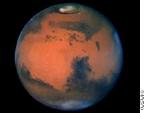 How wet was Mars? Three geologists at Arizona State University have found minerals long exposed on Mars' surface that liquid water would have quickly destroyed. Furthermore, they saw only tiny amounts of clays and similar products that would accumulate in a wet climate. These findings weaken the case that Mars was warm and wet for very long. Perhaps Mars was too cold, and glaciers carved the big erosion channels?
How wet was Mars? Three geologists at Arizona State University have found minerals long exposed on Mars' surface that liquid water would have quickly destroyed. Furthermore, they saw only tiny amounts of clays and similar products that would accumulate in a wet climate. These findings weaken the case that Mars was warm and wet for very long. Perhaps Mars was too cold, and glaciers carved the big erosion channels?
 Joshua L. Bandfield, Timothy D. Glotch and Philip R. Christensen, "Spectroscopic Identification of Carbonate Minerals in the Martian Dust" [abstract], p 1084-1087 v 301, Science, 22 Aug 2003. Joshua L. Bandfield, Timothy D. Glotch and Philip R. Christensen, "Spectroscopic Identification of Carbonate Minerals in the Martian Dust" [abstract], p 1084-1087 v 301, Science, 22 Aug 2003.
 Richard A. Kerr, "Eons of a Cold, Dry, Dusty Mars" [summary], p 1037-1038 v 301, Science, 22 Aug 2003. Richard A. Kerr, "Eons of a Cold, Dry, Dusty Mars" [summary], p 1037-1038 v 301, Science, 22 Aug 2003.
 Study Disputes Mars Ocean Theory, Los Angeles Times, 23 Aug 2003. Study Disputes Mars Ocean Theory, Los Angeles Times, 23 Aug 2003.
 Life on Mars! is the related CA webpage. Life on Mars! is the related CA webpage.
August 14
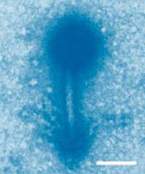 Bacteriophage S-PM2 Bacteriophage S-PM2
scalebar = 100 nm |
Photosynthesis genes in a virus have been detected by biologists at The University of Warwick, Coventry, UK. They write, "We analysed the genome sequence of S-PM2 [pictured], a bacteriophage that infects marine Synechococcus strains and is about 194 kilobases long, and found that it encodes the D1 and D2 proteins of ...a large protein-pigment complex that catalyses the light-dependent oxidation of water to molecular oxygen [in cyanobacteria]."On this website we propose that evolutionary progress depends on gene transfer. If so, one would expect to find advanced genes in transfer mechanisms like viruses.
 Nichols H. Mann et al., "Marine ecosystems: Bacterial photosynthesis genes in a virus" [abstract], p 741 v 424, Nature, 14 Aug 2003. Nichols H. Mann et al., "Marine ecosystems: Bacterial photosynthesis genes in a virus" [abstract], p 741 v 424, Nature, 14 Aug 2003.
 Viruses... is the principal CA webpage about gene transfer. [Next-What'sNEW about HGT-Prev] Viruses... is the principal CA webpage about gene transfer. [Next-What'sNEW about HGT-Prev]
 Photosynthesis evolved by gene transfer — What'sNEW, 24 Nov 2002. Photosynthesis evolved by gene transfer — What'sNEW, 24 Nov 2002.
August 8
Gene transfer, wholesale? "A study of sunflower species that began 15 years ago shows that the sudden mixing and matching of different species' genes can create genetic super-combinations that are considerably more advantageous to the survival and reproduction of their owners than the gene combinations their parents possess." So says an international team headed by biologist Loren Rieseberg of Indiana University. This research reinforces the importance of gene transfer in evolution. [Thanks, Stan Franklin.]
 Loren H. Rieseberg et al., "Major Ecological Transitions in Wild Sunflowers Facilitated by Hybridization" [abstract], p 1211-1216 v 301, Science, 29 Aug 2003. Loren H. Rieseberg et al., "Major Ecological Transitions in Wild Sunflowers Facilitated by Hybridization" [abstract], p 1211-1216 v 301, Science, 29 Aug 2003.
 Richard J. Abbott, "Sex, Sunflowers, and Speciation" [summary], p 1189-1190 v 301, Science, 29 Aug 2003. Richard J. Abbott, "Sex, Sunflowers, and Speciation" [summary], p 1189-1190 v 301, Science, 29 Aug 2003.
 Cross-species mating may be evolutionarily important and lead to rapid change..., Indiana University, 7 Aug 2003. Cross-species mating may be evolutionarily important and lead to rapid change..., Indiana University, 7 Aug 2003.
 Viruses... is the principal CA webpage about gene transfer. [Next-What'sNEW about HGT-Prev] Viruses... is the principal CA webpage about gene transfer. [Next-What'sNEW about HGT-Prev]
 Why Sexual Reproduction? is a related CA webpage. Why Sexual Reproduction? is a related CA webpage.
 Macroevolutionary Progress Redefined... is a CA webpage suggesting that transfer may be required for progress. Macroevolutionary Progress Redefined... is a CA webpage suggesting that transfer may be required for progress.
August 6
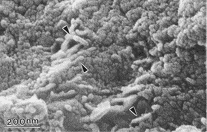
Nanobes in ALH84001 |
Just balls of protein? This is Nature's suggested description for nanofossils like the ones seen in a meteorite from Mars seven years ago. At that time NASA reported that evidence in a meteorite (designated ALH 84001) pointed to former life on Mars. NASA's team, headed by David S. McKay, cited four lines of evidence, one of which was the presence of fossils resembling nanobacteria — later renamed "nanobes." They are too small to contain the genome of a cell, but nanobes are apparently biological products, because they have DNA, protein, and a means to be multiplied, we now know. Nanobes may be the distress byproducts of whole bacteria, for example."Now Jürgen Schieber, of Indiana University in Bloomington, and Howard Arnott, of the University of Texas at Arlington, report that spherical balls of protein about 40-120 nanometres across are produced when organic material decays in an environment like that in which sedimentary rocks form." "Schieber and Arnott dipped pieces of bean, squid and beef into the muck scooped from a pond bed, coating them in a range of natural bacteria, and then buried the samples under clay in a water tank. Over the next fortnight the researchers regularly studied samples under the microscope. The tissues, they found, became covered in spherical blobs of organic matter." From this Schieber and Arnott conclude, "Most, if not all alleged nanobacterial structures in sedimentary rocks are not evidence for minute life forms." Because they are evidence for larger forms like beans, squid and beef? If nanobes are just balls of protein produced in the manner of Schieber and Arnott, their fossils would be even more dramatic evidence for former life, one could claim. [Thanks, Larry Klaes.]

 Jürgen Schieber and Howard J. Arnott, "Nannobacteria as a by-product of enzyme-driven tissue decay" [abstract], p 717–720 v 31 n 8, Geology, Aug 2003. Jürgen Schieber and Howard J. Arnott, "Nannobacteria as a by-product of enzyme-driven tissue decay" [abstract], p 717–720 v 31 n 8, Geology, Aug 2003.
 Nanofossils may be digested organic matter, by Philip Ball, Nature News Service, 6 Aug 2003. Nanofossils may be digested organic matter, by Philip Ball, Nature News Service, 6 Aug 2003.
 Chomping on Nano-Nuggets, by Leslie Mullen, Astrobiology Magazine, 17 Sep 2003. Chomping on Nano-Nuggets, by Leslie Mullen, Astrobiology Magazine, 17 Sep 2003.
 David S. McKay et al., "Search for Past Life on Mars: Possible Relic Biogenic Activity in Martian Meteorite ALH84001" [abstract], p 924-930 v 273, Science, 16 August 1996. David S. McKay et al., "Search for Past Life on Mars: Possible Relic Biogenic Activity in Martian Meteorite ALH84001" [abstract], p 924-930 v 273, Science, 16 August 1996.
 Life on Mars! is a CA webpage with references and links about nanobes and ALH 84001. Life on Mars! is a CA webpage with references and links about nanobes and ALH 84001.
 Nanobes is the subject of a reply to CA from Michael Paine, 10 Aug 2003. Nanobes is the subject of a reply to CA from Michael Paine, 10 Aug 2003.

|
 A river in Spain may model Mars' environment and help NASA learn how to look for life on the red planet. At the Sixth International Mars Society Conference in Eugene Oregon, 14-17 August, Carol Stoker of NASA, Ames, explains that bacteria might dwell underground on Mars as they do near Spain's very acidic Rio Tinto. This research is part of the Mars Analog Research and Technology Experiment (MARTE). [Thanks, Marsbugs.]
A river in Spain may model Mars' environment and help NASA learn how to look for life on the red planet. At the Sixth International Mars Society Conference in Eugene Oregon, 14-17 August, Carol Stoker of NASA, Ames, explains that bacteria might dwell underground on Mars as they do near Spain's very acidic Rio Tinto. This research is part of the Mars Analog Research and Technology Experiment (MARTE). [Thanks, Marsbugs.] Galileo will crash into Jupiter on Sunday, 21 September. NASA is destroying the spacecraft this way to assure that it doesn't contaminate Europa with earthly microbes. Striking Jupiter's dense atmosphere at over 100,000 mph, the probe should be pulverized and its contents sterilized by intense heat. Launched in 1989, Galileo has returned images and information from Jupiter and its moons since December 1995.
Galileo will crash into Jupiter on Sunday, 21 September. NASA is destroying the spacecraft this way to assure that it doesn't contaminate Europa with earthly microbes. Striking Jupiter's dense atmosphere at over 100,000 mph, the probe should be pulverized and its contents sterilized by intense heat. Launched in 1989, Galileo has returned images and information from Jupiter and its moons since December 1995. The theological implications of life elsewhere are considered by astrobiologist Paul Davies in The Atlantic Monthly. The topic has interested him at least since he wrote Are We Alone? (Basic Books, 1995.) The topic interest us too, but in this writing Davies has blinders on when he discusses the possible implications if life is found on Mars. "If traces of past life were discovered on Mars but found to be identical to some form of terrestrial life, transportation by ejected rocks would be the most plausible explanation, and we would still lack evidence that life had started from scratch in two separate locations." Yes we would. In fact, we would lack evidence that life had started from scratch in either location. It may have come to both planets from a cosmic source. [Thanks, Jim McGee.]
The theological implications of life elsewhere are considered by astrobiologist Paul Davies in The Atlantic Monthly. The topic has interested him at least since he wrote Are We Alone? (Basic Books, 1995.) The topic interest us too, but in this writing Davies has blinders on when he discusses the possible implications if life is found on Mars. "If traces of past life were discovered on Mars but found to be identical to some form of terrestrial life, transportation by ejected rocks would be the most plausible explanation, and we would still lack evidence that life had started from scratch in two separate locations." Yes we would. In fact, we would lack evidence that life had started from scratch in either location. It may have come to both planets from a cosmic source. [Thanks, Jim McGee.] Oceans and pleasant temperatures may have persisted on Venus for two billion years. So says David Grinspoon of the Southwest Research Institute in Texas, who included the effect of clouds on the Venusian atmosphere in his calculations. This work was presented at the American Astronomical Society's Division for Planetary Sciences meeting in Monterey, California, 6 September. [Thanks, Marsbugs.]
Oceans and pleasant temperatures may have persisted on Venus for two billion years. So says David Grinspoon of the Southwest Research Institute in Texas, who included the effect of clouds on the Venusian atmosphere in his calculations. This work was presented at the American Astronomical Society's Division for Planetary Sciences meeting in Monterey, California, 6 September. [Thanks, Marsbugs.] Earth's water came from comets? Many scientists think the oceans must have arrived that way, after Earth cooled from its original boiling hot condition. Surprisingly however, planets completely covered by a deep ocean should be common, according to a team at The University of Washington who used computer models to study how planets coalesce.
Earth's water came from comets? Many scientists think the oceans must have arrived that way, after Earth cooled from its original boiling hot condition. Surprisingly however, planets completely covered by a deep ocean should be common, according to a team at The University of Washington who used computer models to study how planets coalesce. Could alien pathogens wreak havoc on our world? Three missions that will bring extraterrestrial material back to Earth are already under way. One, Japan's MUSES-C spacecraft (pictured), was launched in May 2003, bound for for asteroid 1998 SF36. There it will attempt to gather a small amount of material and return to Earth by June 2007. NASA's Stardust mission is on the way to comet Wild 2 to collect cometary dust particles for return in January 2006. And NASA's Genesis mission is now collecting solar wind samples for return in September 2004. Other future sample return missions are at various stages of development at NASA, ESA and Japan's ISAS. Material returned from space may well contain viable microorganisms, we now agree. Therefore, we must handle the samples with caution.
Could alien pathogens wreak havoc on our world? Three missions that will bring extraterrestrial material back to Earth are already under way. One, Japan's MUSES-C spacecraft (pictured), was launched in May 2003, bound for for asteroid 1998 SF36. There it will attempt to gather a small amount of material and return to Earth by June 2007. NASA's Stardust mission is on the way to comet Wild 2 to collect cometary dust particles for return in January 2006. And NASA's Genesis mission is now collecting solar wind samples for return in September 2004. Other future sample return missions are at various stages of development at NASA, ESA and Japan's ISAS. Material returned from space may well contain viable microorganisms, we now agree. Therefore, we must handle the samples with caution. How wet was Mars? Three geologists at Arizona State University have found minerals long exposed on Mars' surface that liquid water would have quickly destroyed. Furthermore, they saw only tiny amounts of clays and similar products that would accumulate in a wet climate. These findings weaken the case that Mars was warm and wet for very long. Perhaps Mars was too cold, and glaciers carved the big erosion channels?
How wet was Mars? Three geologists at Arizona State University have found minerals long exposed on Mars' surface that liquid water would have quickly destroyed. Furthermore, they saw only tiny amounts of clays and similar products that would accumulate in a wet climate. These findings weaken the case that Mars was warm and wet for very long. Perhaps Mars was too cold, and glaciers carved the big erosion channels?

